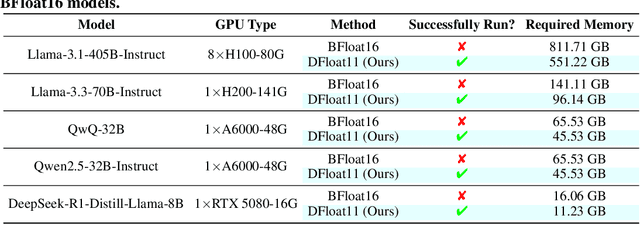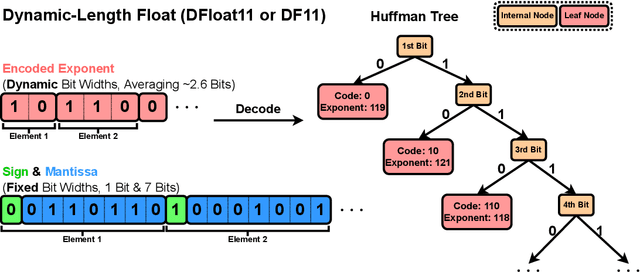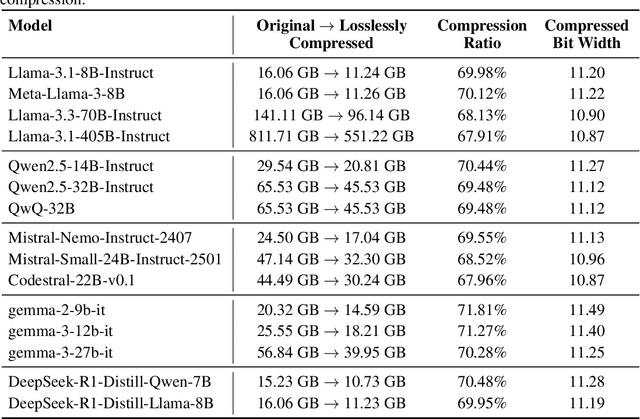Vipin Chaudhary
Demystifying Hybrid Thinking: Can LLMs Truly Switch Between Think and No-Think?
Oct 14, 2025Abstract:Hybrid thinking enables LLMs to switch between reasoning and direct answering, offering a balance between efficiency and reasoning capability. Yet our experiments reveal that current hybrid thinking LLMs only achieve partial mode separation: reasoning behaviors often leak into the no-think mode. To understand and mitigate this, we analyze the factors influencing controllability and identify four that matter most: (1) larger data scale, (2) using think and no-think answers from different questions rather than the same question, (3) a moderate increase in no-think data number, and (4) a two-phase strategy that first trains reasoning ability and then applies hybrid think training. Building on these findings, we propose a practical recipe that, compared to standard training, can maintain accuracy in both modes while significantly reducing no-think output length (from $1085$ to $585$ on MATH500) and occurrences of reasoning-supportive tokens such as ``\texttt{wait}'' (from $5917$ to $522$ on MATH500). Our findings highlight the limitations of current hybrid thinking and offer directions for strengthening its controllability.
Don't Pass$\mathtt{@}k$: A Bayesian Framework for Large Language Model Evaluation
Oct 05, 2025Abstract:Pass$@k$ is widely used to report performance for LLM reasoning, but it often yields unstable, misleading rankings, especially when the number of trials (samples) is limited and compute is constrained. We present a principled Bayesian evaluation framework that replaces Pass$@k$ and average accuracy over $N$ trials (avg$@N$) with posterior estimates of a model's underlying success probability and credible intervals, yielding stable rankings and a transparent decision rule for differences. Evaluation outcomes are modeled as categorical (not just 0/1) with a Dirichlet prior, giving closed-form expressions for the posterior mean and uncertainty of any weighted rubric and enabling the use of prior evidence when appropriate. Theoretically, under a uniform prior, the Bayesian posterior mean is order-equivalent to average accuracy (Pass$@1$), explaining its empirical robustness while adding principled uncertainty. Empirically, in simulations with known ground-truth success rates and on AIME'24/'25, HMMT'25, and BrUMO'25, the Bayesian/avg procedure achieves faster convergence and greater rank stability than Pass$@k$ and recent variants, enabling reliable comparisons at far smaller sample counts. The framework clarifies when observed gaps are statistically meaningful (non-overlapping credible intervals) versus noise, and it naturally extends to graded, rubric-based evaluations. Together, these results recommend replacing Pass$@k$ for LLM evaluation and ranking with a posterior-based, compute-efficient protocol that unifies binary and non-binary evaluation while making uncertainty explicit. Code is available at https://mohsenhariri.github.io/bayes-kit
LABELING COPILOT: A Deep Research Agent for Automated Data Curation in Computer Vision
Sep 26, 2025Abstract:Curating high-quality, domain-specific datasets is a major bottleneck for deploying robust vision systems, requiring complex trade-offs between data quality, diversity, and cost when researching vast, unlabeled data lakes. We introduce Labeling Copilot, the first data curation deep research agent for computer vision. A central orchestrator agent, powered by a large multimodal language model, uses multi-step reasoning to execute specialized tools across three core capabilities: (1) Calibrated Discovery sources relevant, in-distribution data from large repositories; (2) Controllable Synthesis generates novel data for rare scenarios with robust filtering; and (3) Consensus Annotation produces accurate labels by orchestrating multiple foundation models via a novel consensus mechanism incorporating non-maximum suppression and voting. Our large-scale validation proves the effectiveness of Labeling Copilot's components. The Consensus Annotation module excels at object discovery: on the dense COCO dataset, it averages 14.2 candidate proposals per image-nearly double the 7.4 ground-truth objects-achieving a final annotation mAP of 37.1%. On the web-scale Open Images dataset, it navigated extreme class imbalance to discover 903 new bounding box categories, expanding its capability to over 1500 total. Concurrently, our Calibrated Discovery tool, tested at a 10-million sample scale, features an active learning strategy that is up to 40x more computationally efficient than alternatives with equivalent sample efficiency. These experiments validate that an agentic workflow with optimized, scalable tools provides a robust foundation for curating industrial-scale datasets.
$K^4$: Online Log Anomaly Detection Via Unsupervised Typicality Learning
Jul 26, 2025Abstract:Existing Log Anomaly Detection (LogAD) methods are often slow, dependent on error-prone parsing, and use unrealistic evaluation protocols. We introduce $K^4$, an unsupervised and parser-independent framework for high-performance online detection. $K^4$ transforms arbitrary log embeddings into compact four-dimensional descriptors (Precision, Recall, Density, Coverage) using efficient k-nearest neighbor (k-NN) statistics. These descriptors enable lightweight detectors to accurately score anomalies without retraining. Using a more realistic online evaluation protocol, $K^4$ sets a new state-of-the-art (AUROC: 0.995-0.999), outperforming baselines by large margins while being orders of magnitude faster, with training under 4 seconds and inference as low as 4 $\mu$s.
AutoL2S: Auto Long-Short Reasoning for Efficient Large Language Models
May 28, 2025Abstract:The reasoning-capable large language models (LLMs) demonstrate strong performance on complex reasoning tasks but often suffer from overthinking, generating unnecessarily long chain-of-thought (CoT) reasoning paths for easy reasoning questions, thereby increasing inference cost and latency. Recent approaches attempt to address this challenge by manually deciding when to apply long or short reasoning. However, they lack the flexibility to adapt CoT length dynamically based on question complexity. In this paper, we propose Auto Long-Short Reasoning (AutoL2S), a dynamic and model-agnostic framework that enables LLMs to dynamically compress their generated reasoning path based on the complexity of the reasoning question. AutoL2S enables a learned paradigm, in which LLMs themselves can decide when longer reasoning is necessary and when shorter reasoning suffices, by training on data annotated with our proposed method, which includes both long and short CoT paths and a special <EASY> token. We then use <EASY> token to indicate when the model can skip generating lengthy CoT reasoning. This proposed annotation strategy can enhance the LLMs' ability to generate shorter CoT reasoning paths with improved quality after training. Extensive evaluation results show that AutoL2S reduces the length of reasoning generation by up to 57% without compromising performance, demonstrating the effectiveness of AutoL2S for scalable and efficient LLM reasoning.
Grammars of Formal Uncertainty: When to Trust LLMs in Automated Reasoning Tasks
May 26, 2025Abstract:Large language models (LLMs) show remarkable promise for democratizing automated reasoning by generating formal specifications. However, a fundamental tension exists: LLMs are probabilistic, while formal verification demands deterministic guarantees. This paper addresses this epistemological gap by comprehensively investigating failure modes and uncertainty quantification (UQ) in LLM-generated formal artifacts. Our systematic evaluation of five frontier LLMs reveals Satisfiability Modulo Theories (SMT) based autoformalization's domain-specific impact on accuracy (from +34.8% on logical tasks to -44.5% on factual ones), with known UQ techniques like the entropy of token probabilities failing to identify these errors. We introduce a probabilistic context-free grammar (PCFG) framework to model LLM outputs, yielding a refined uncertainty taxonomy. We find uncertainty signals are task-dependent (e.g., grammar entropy for logic, AUROC>0.93). Finally, a lightweight fusion of these signals enables selective verification, drastically reducing errors (14-100%) with minimal abstention, transforming LLM-driven formalization into a reliable engineering discipline.
100-LongBench: Are de facto Long-Context Benchmarks Literally Evaluating Long-Context Ability?
May 25, 2025



Abstract:Long-context capability is considered one of the most important abilities of LLMs, as a truly long context-capable LLM enables users to effortlessly process many originally exhausting tasks -- e.g., digesting a long-form document to find answers vs. directly asking an LLM about it. However, existing real-task-based long-context evaluation benchmarks have two major shortcomings. First, benchmarks like LongBench often do not provide proper metrics to separate long-context performance from the model's baseline ability, making cross-model comparison unclear. Second, such benchmarks are usually constructed with fixed input lengths, which limits their applicability across different models and fails to reveal when a model begins to break down. To address these issues, we introduce a length-controllable long-context benchmark and a novel metric that disentangles baseline knowledge from true long-context capabilities. Experiments demonstrate the superiority of our approach in effectively evaluating LLMs.
Longer Context, Deeper Thinking: Uncovering the Role of Long-Context Ability in Reasoning
May 22, 2025Abstract:Recent language models exhibit strong reasoning capabilities, yet the influence of long-context capacity on reasoning remains underexplored. In this work, we hypothesize that current limitations in reasoning stem, in part, from insufficient long-context capacity, motivated by empirical observations such as (1) higher context window length often leads to stronger reasoning performance, and (2) failed reasoning cases resemble failed long-context cases. To test this hypothesis, we examine whether enhancing a model's long-context ability before Supervised Fine-Tuning (SFT) leads to improved reasoning performance. Specifically, we compared models with identical architectures and fine-tuning data but varying levels of long-context capacity. Our results reveal a consistent trend: models with stronger long-context capacity achieve significantly higher accuracy on reasoning benchmarks after SFT. Notably, these gains persist even on tasks with short input lengths, indicating that long-context training offers generalizable benefits for reasoning performance. These findings suggest that long-context modeling is not just essential for processing lengthy inputs, but also serves as a critical foundation for reasoning. We advocate for treating long-context capacity as a first-class objective in the design of future language models.
SELF: Self-Extend the Context Length With Logistic Growth Function
May 22, 2025Abstract:Large language models suffer issues when operated on long contexts that are larger than their training context length due to the standard position encoding for tokens in the attention layer. Tokens a long distance apart will rarely have an effect on each other and long prompts yield unexpected results. To solve this problem, we propose SELF (Self-Extend the Context Length With Logistic Growth Function): a solution of grouping consecutive tokens at varying group sizes using a logistic capacity equation combined with a constant group size at smaller relative distances. Our model had an increase in performance of up to 12% compared to the LongLM extension method in LEval (specifically on the Qwen model). On summarization related tasks in LongBench, our model performed up to 6.4% better than LongLM (specifically on the Llama-2-7b model). On reading comprehension tasks from LEval, our model performed up to 5.4% better than the LongLM. Our code is available at https://github.com/alexeipc/SELF-LLM.
70% Size, 100% Accuracy: Lossless LLM Compression for Efficient GPU Inference via Dynamic-Length Float
Apr 15, 2025



Abstract:Large Language Models (LLMs) have grown rapidly in size, creating significant challenges for efficient deployment on resource-constrained hardware. In this paper, we introduce Dynamic-Length Float (DFloat11), a lossless compression framework that reduces LLM size by 30% while preserving outputs that are bit-for-bit identical to the original model. DFloat11 is motivated by the low entropy in the BFloat16 weight representation of LLMs, which reveals significant inefficiency in existing storage format. By applying entropy coding, DFloat11 assigns dynamic-length encodings to weights based on frequency, achieving near information-optimal compression without any loss of precision. To facilitate efficient inference with dynamic-length encodings, we develop a custom GPU kernel for fast online decompression. Our design incorporates the following: (i) decomposition of memory-intensive lookup tables (LUTs) into compact LUTs that fit in GPU SRAM, (ii) a two-phase kernel for coordinating thread read/write positions using lightweight auxiliary variables, and (iii) transformer-block-level decompression to minimize latency. Experiments on recent models, including Llama-3.1, Qwen-2.5, and Gemma-3, validates our hypothesis that DFloat11 achieves around 30% model size reduction while preserving bit-for-bit exact outputs. Compared to a potential alternative of offloading parts of an uncompressed model to the CPU to meet memory constraints, DFloat11 achieves 1.9-38.8x higher throughput in token generation. With a fixed GPU memory budget, DFloat11 enables 5.3-13.17x longer context lengths than uncompressed models. Notably, our method enables lossless inference of Llama-3.1-405B, an 810GB model, on a single node equipped with 8x80GB GPUs. Our code and models are available at https://github.com/LeanModels/DFloat11.
 Add to Chrome
Add to Chrome Add to Firefox
Add to Firefox Add to Edge
Add to Edge